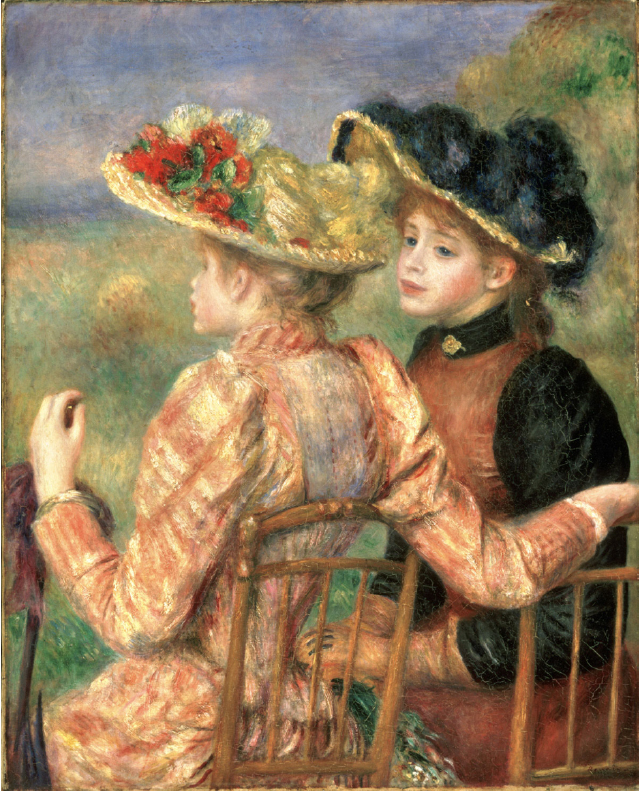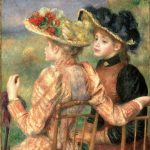Two Young Girls, Pierre-Auguste Renoir, oil on canvas, 32 1/4 x 25 13/16 inches, 1892, Philadelphia Museum of Art
Renoir Reconsidered: Plastic Analysis by DoN Brewer
Two Young Girls is a vertical oil painting composed of a matrix of radiating lines, curving structural segments, twisted, intertwining, interlocking shapes, multicolorful compartmentalized color, and shimmering, glowing light effects that suffuse the canvas with illumination, shadow, warmth and liveness. The subject facts include two girls seated outdoors in a sunny landscape, wearing fancy hats and stylish dresses, perched on spindly wooden garden chairs.
Line
The painting is composed of a complex set of orthogonal lines that emanate from the lower center section of the composition, three dark lines of seams on gloved hands, begin a radiating upward pattern of lines connecting the figures in a curvilinear, twisting, folding design that is intimate, unified, creating a continuum of plastic elements. The curving lines repeat with the top of the chair, the combined shoulders of the girls and the dramatic sweep of the hats. Like space invaders the girl’s hat on the left swoops under the right hat in the top third of the composition but the gloved hands of the girl on the right pokes her partner’s ribs in the bottom third.
Orthogonal lines radiate out like a fan or a parasol from the curved stripes of the gloves developing compartmentalized fields of shapes defined by color and light; the vanishing point is obscured by the figures, the atmosphere of sun drenched land and sky surrounds and permeates the duo, the landscape tilts up to a blurred horizon line visible on the left, a tree line meets the sky on the right.
Focusing on the gloved hand in the lower center, lines radiate outward connecting to the bottom of the canvas on both sides of the chair in the middle, towards the hand resting on the purple parasol on the left, diagonally through the shoulder along the cheek and past the hat to the upper left corner, a line to the face of the girl on the right, one through her shoulder letting the tree clump fill the right upper corner, lines reach across to the right lower edge of the canvas through the girl’s arms, and finally along the bunch of flowers in the lap of the girl on the right to the lower right of the picture.
We observe an interconnected radiating web of orthogonal lines, sweeping upward with curvilinear lines and a clever use of Mobius strips mixing the two elaborate hats infinitely, the enwrapping arms entwining the duo in volumetric space, and flowing, fluid, ray traced movement between the figures. The figure eight motif causes the eye to move through the composition, the hats become one unit, the figures swirl together, and even though the portrait of the girl on the right is so distinct and prominent, the infinity shape connecting the hats pushes the portrait forward; the hat on the left seems to be under the hat on the right, creating an illusory movement through curvilinear shapes and arabesque line.
Shape
Even though there are straight lines in the composition they describe circular objects like the chair spindles and the parasol; the stripes on the dress on the left are broken lines and undulate across the textile surface fluidly. The predominant shapes are rounded, voluminous, and connected across the composition developing circumambient space within a shallow depth of field; two young girls engaged in conversation, displaying poise and style, with us, the viewers, conveniently within eves-dropping distance. The fashionable hats perched on the girls’ heads dominate the top third of the painting, the Mobius strip effect of the two objects links the figures in an infinite looping motion with a whirling twist like a DNA strand. The creatively distorted blobby shapes on the hats read as flowers and feathers but are fluffy, wispy puffs of color painted thickly with feathery edges.
The variety of shapes and their connections across orthogonal planes develops an interlocking composition of round, square and triangular spaces: circles, ellipses, and mounds of the hats and heads at the top, textiles and the rounded shapes of shoulders, arms and upper torso fill the middle, a sandwich design, and rings, tubes, and semi-circles of rods, cuffs, and collars, the rectangles of chair backs and the panel of the dress on the left, and layer upon layer of interlocking triangles weaving up and down, in and out, from the lower center where the gloved hands clasp, unify the duo as one swirled object. The upturned cone of the torso on the left is echoed by the pointy shapes of the purple umbrella in the lower left corner, the gloved hands unfold triangles towards the right. The combination of geometric shapes, twisted enfolding tubes, radiating triangles, and circular forms, coalesce into a compelling volumetric composition that is structured and solid yet fluid, with up and down movement, back and forth zigzags, and forward and backward organization of shapes.
Color
Renoir applies color in a mode enhancing the illustrative qualities of the composition while delighting the viewer with dramatic decorativeness and social liveliness. The palette balances warm and cool colors like contrasting solemn burnt Venetian red with deep Prussian blue in a subdued low key with bright ivory, luscious pink, pale greens and yellows in an exuberant high key enhanced with bursts of ebullient colorful contrasting reds and greens and an unexpected flourish of purple creating an elegant balance of color equivalents.
Color is compartmentalized in solid forms then appears across the picture plane in subtly unifying swatches and patches. Arguably the blue hat is the most prominent color shape in the composition because of the darkness against the multicolorful landscape; the feathery puffs are piled high flowing over the brim in circles, ovals and ellipses in deep blue, the splotches of pale blues and grays reflecting sunlight smudge out over the edges and mix with the sky and landscape echoing the smooth cobalt blue sky smeared across the top of the canvas with wide strokes, and overlapping into the greens and yellows of the landscape.
The hat on the left is overflowing with floral shapes, half red floral shapes with green leaves, half ochre, cadmium yellow, and pale green, like a floral still life spilling out of the hat basket; the brushstrokes are multidirectional, a mixture of long and short, swirly and amorphous, coiled and smudged, like the rolling foliage of the landscape. The two hats are unified by the yellow brims, an infinite swirl, the Mobius strip, of yellow, earthy ochre, and pale orange glazed over lumpy white paint, highly textural and glinting, the broken lines describing the tactile grain of the straw weave of the millinery shiny in the sun, fluffy feathers absorbing light and brilliant flowers reflecting the sun rays.
Flesh painting is constrained to the portraits of the two young girls along with one girl’s hand and wrist smoothly painted in ivory, pink, with shadows of pale blue and violet; the girl on the right has glowing red cheeks and burning red ear, like the red flowers of her partner’s hat, the girl on the left, with barely there features, is painted with ivory, light pink, and pale purple, the hair transfuses into pale orange and blue, the dark shadow defining the upswept hair as blue as the stripe in her partner’s hat.
Renoir’s limited palette is utilized to astonishing effect: mixing lake red with white creates a lovely pearly pink for flesh and fabric, cadmium yellow color chorded with streaks of bluish gray is strong and wooden, and viridian green glows in the landscape and along edges of the textile with brilliant contrast and light. The textile painting of the pink dress is applied thickly with piles of paint layered in pale Naples yellow, carmine mixed with white, and dramatic strokes of bold pure red making the shadows of fabric folds ornate and vivid, revealing weave, weight, and texture along with the fancy pattern and flattering color. The darker dress on the right compartmentalizes cobalt and black against red oxide, with strokes of green, blue, purple and ochre painted smoothly, densely, and layered across the shapes in dapples, smudges, washes and daubs from all the colors of the artist’s palette – her dress isn’t so plain, after all.
Light
Renoir creates spatial depth and light through color; the cobalt blue sky is smudgy and scudded with washes of pure blue, smoky gray and pearly, opalescent white that transfuses into the blue streaks of a pale horizon, the foliage of the landscape greedily sucks in light and reflects it back with Viridian green, Indian yellow, and cobalt blue with fluffy pounces of the brush, while the textiles absorb and transmit light through structural color, convincing contrasts, and color modeling. Light is the constant in the composition pervading structural elements such as flesh, fabric, landscape and still life with deliberate and controlled mixtures of limited color choices with white and black, thickness and thinness of paint application, directionality of brush strokes, and gradations of color mixture from dark darks to light lights into an infinite variety of colorful light and shadow.
Look at the gloved hands; appearing to be leather with thick stitching, folding and wrapping around the hands and forearms with all the colors of the palette describing atmosphere and temperature with short multicolorful strokes of ochre, cobalt, reds, and yellows that merge into segmented shapes and a unified color field informing the entire composition. Lastly, the purple umbrella in the lower left, a mix of lake red and cobalt, black and white, whirled into a fabulous violet in strokes of thick paint in thin chorded striations; the handle of the parasol wraps the wrist and literally glows, the thick textural paint reflects the gallery lights, as if the sun is glinting off the silvery curve while the colors of the landscape and figures are reflected in primary shades of blue, red, and yellow.
Click for large picture.
Final project for the Barnes – de Mazia Certificate in Art and Aesthetics, The Barnes Foundation
Thank you to my instructors, particularly William M. Perthes, for sharing their knowledge and letting me share what I know, too.
Written by DoN Brewer.
Like DoNArTNeWs Philadelphia Art News Blog on facebook
Follow DoN on Twitter @DoNNieBeat58
@donniebeat on Instagram
More DoNArTNeWs at www.brewermultimedia.com
Affiliate Marketing Disclosure Statement
Donate via safe and secure PayPal in the sidebar.
DoNArTNeWs celebrating ten years reporting on Philadelphia art and artists.





{ 0 comments… add one now }
You must log in to post a comment.